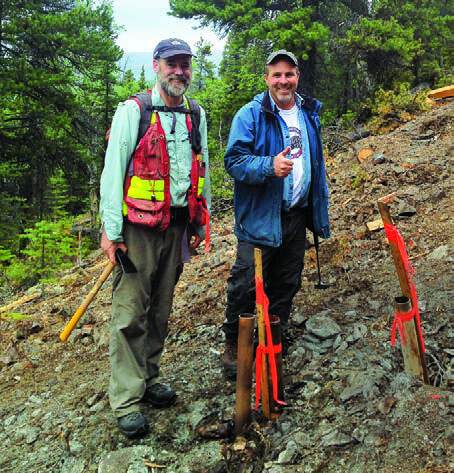The exceptional mineral endowment of northwestern British Columbia has lured prospectors and exploration companies for more than a century, despite rugged topography and the lack of roads and infrastructure. Much of this activity has focused on the Stikine terrane, the largest and westernmost of several exotic terranes in the Intermontane Belt of the Canadian Cordillera. This large volcanicarc assemblage hosts several prolific past-producing mines, the new Red Chris copper-gold mine, the Brucejack gold-silver mine project, the permitted KSM goldcopper deposit, and dozens of promising exploration and development projects.
The generally northwest-trending Stikine terrane (also known as Stikina or the Stikine Arch) spans more than 1,500 kilometres across the length of the province and varies from more than 300 kilometres to less than 100 kilometres in width. Gold was the main target of pioneerera prospectors, but only a few mines were developed. The pace of discovery accelerated in the 1950s, spurred by the advent of helicopter-supported exploration and the recognition that the region was prospective for porphyry copper deposits similar to those mined in the United States and Chile. The Granduc copper mine was explored and developed during this period, and operated from 1964 to 1984.
The ability to “look down” on vast swaths of prospective ground, combined with the introduction of geochemical and geophysical techniques, inspired a series of exploration booms that involved mining giants and hundreds of junior companies. Red Chris, Brucejack and KSM all benefited from this historic legacy, which also led to the development of the Premier, Eskay Creek and Snip gold mines, and the advancement of porphyry deposits such as Galore Creek and Schaft Creek, and the porphyryrelated Red Mountain gold deposit.
Recent research by JoAnne Nelson and Jeff Kyba has shown that the tectonic and structural setting of the Stikine terrane is similar to productive mining belts in the Philippines and Indonesia, despite intense deformation and compression that has obscured clues related to the emplacement of mineral deposits in Stikina. The implications are exciting, as deposits in the belt may have sizable extensions and high-grade roots that weren’t previously recognized or pursued.
The potential for discoveries was also enhanced by identifying the most prospective portions of the belt. The Stikine terrane was built during three episodes of island arc formation between the late Paleozoic and early Mesozoic eras; these stratigraphic units are commonly known as the Stuhini Group, the Hazelton Group and the Bowser Lake group. Nelson and Kyba’s research has identified the unconformity between the Stuhini and Hazelton groups as an important regional “red line” marker for finding porphyry and related deposits, and has also shown that nearby fault systems influence the emplacement of mineralized intrusions.
Companies are benefiting from this breakthrough, including Colorado Resources, which reported two porphyry discoveries at its KSP property and the discovery of a new zone and the expansion of main zone mineralization to depth at its North ROK property near Red Chris.

President and CEO Adam Travis says the BC Geological Survey has provided a “big picture” of the belt that provides a framework for detailed property work. “For us dreamers who have worked in the belt since the ’80s, this [research] has helped us sell our story and continue to explore.”
Travis says investments in roads and infrastructure, such as the Northwest Transmission Line and run-of-river power projects, are also spurring recent exploration and development activity.
The Red Chris mine operated by Imperial Metals has benefited from both new infrastructure and new exploration concepts. First drilled in 1956, recent exploration has expanded known zones and revealed higher-grade zones at depth. Red Chris is expected to produce 90 to 100 million pounds of copper and 60,000 to 70,000 ounces of gold in 2016.
Pretium Resources Inc.’s Brucejack project was explored from the early 1960s through the 1990s, but was transformed by the discovery of the Valley of the Kings deposit. Now in the construction phase, the underground mine project hosts measured and indicated resources totalling 16.4 million tonnes at 17.2 grams per tonne (9.1 million contained ounces of gold).
Seabridge Gold has expanded the KSM copper-gold deposit northeast of Stewart. Previously explored by Placer Dome and others, KSM is a proposed combined openpit and underground operation with proven and probable reserves containing 38.2 million ounces of gold, 9.9 billion pounds of copper, 191 million ounces of silver and 213 million pounds of molybdenum.
Red Mountain was extensively explored in the 1990s, but has evolved into a development project under present owner IDM Mining. A 2016 preliminary economic assessment envisioned a high-grade underground mine with annual average production of 70,000 ounces of gold and 194,000 ounces of silver. The project is in the early stage of the permitting process.
Travis says the Stikine terrane is poised for another exploration boom that will lead to new discoveries, including at historic mines and projects. “Government [geosciences] research is invaluable and provides a roadmap for targeted exploration. It’s adding fuel to the fire.”
